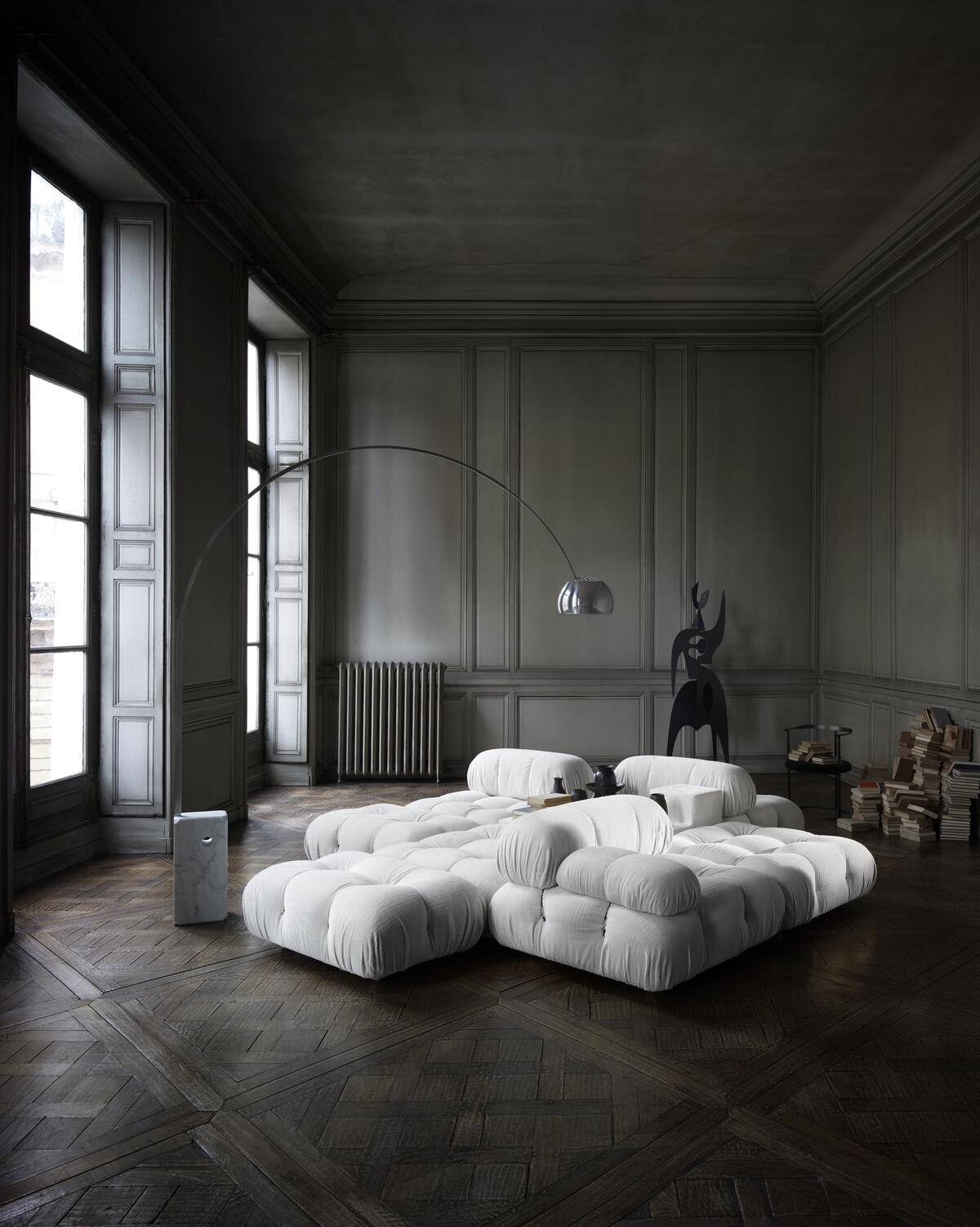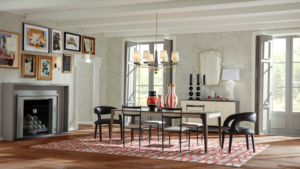During Milan Design Week, most brands debut new product. B&B Italia is showcasing a new CEO. Last December, the furniture group—which includes Italian brands Maxalto and Azucena—appointed Demetrio Apolloni to the top spot, replacing Gilberto Negrini. Four months later, Apolloni is headed into his first Milan fair at the helm, just as the brand showcases an intriguing lineup of new pieces alongside deep cuts from its existing collection.
A look back at B&B Italia’s history is a good fit for Apolloni, who spent 13 years at the brand earlier in his career. A veteran design executive who has since held key positions at the likes of Knoll, Vitra and Cassina, in the early 2000s Apolloni helped develop B&B Italia’s presence in the U.S. Nearly two decades later, this appointment marks a homecoming.
Apolloni rejoins B&B Italia at a pivotal moment. In 2018 the company was acquired by Design Holding, a private-equity-backed high-design conglomerate that includes Flos, Louis Poulsen and Fendi Casa. Design Holding is an ambitious venture: Its self-stated goal is to become “the LVMH of home.” For that to happen, B&B Italia’s family of brands will need to grow—and the company is clearly betting that the U.S. is a good place to do it. Over the past 12 months, it has opened new showrooms in Miami, New York and Washington, D.C., with Boston next on the docket.
The brand is also fresh off a huge hit. Its 2020 reissue of Mario Bellini’s bulbous 1970s classic, the Camaleonda, became the “it” sofa of the pandemic era, finding its way into the homes of celebrities, artists, influencers, and countless amateur aesthetes with a stimulus check burning a hole in their pocket. Chrissy Teigen owns one, as does artist Daniel Arsham. Athena Calderone called it “the sexiest sofa in existence.”
Business of Home spoke with Apolloni about the opportunities and challenges of the U.S. market, what lies ahead, and why he doesn’t want B&B Italia to be defined by a runaway hit, no matter how popular.
Looking back to the early 2000s, when you were running B&B Italia’s U.S. operations, what were the challenges at the time, and what has changed?
What’s interesting is that it’s not easy to improve the network. If I go back to 2003, my account was 40 dealers in all of the U.S. Now, in 2024, we’re still at 40. So you didn’t have an expansion of multibrand stores—but you can see more and more [single-brand] stores.
If you look at B&B Italia, we have our showroom on 58th Street in Manhattan. In Boston, we [used to sell through a multibrand store called] Montage, but we’ve acquired Montage, and it will be under our brand. In Washington, D.C., we have our own branded store now—it used to be managed by a private dealer. In Miami, [we used to sell through Luminaire]; now we have our branded store. We’re in more markets directly, and there’s more implementation to allow us to show the brand.
Is that the U.S. strategy in a nutshell: more branded stores and more direct control?
If it makes sense to work with a local partner, I like the knowledge and the experience. But if you are not able to find the right partner and you know the market and you have the organization, you can [grow your own] network.
What do you think the brand recognition of B&B Italia is in the U.S.?
If you ask me about the end user, it would be difficult to say. If you ask me about trade, I believe we can be in the top 10. When you think about furniture companies, no doubt you could say Herman Miller, Knoll, and then Design Within Reach and Restoration Hardware. But if you look at international brands, not only domestic companies, I believe B&B Italia came into the [U.S.] market in the 1970s [and] I can say that during my time, the investment in advertising was always very important, but always to the trade—we’re not always able to [reach] the end user. But in terms of brand recognition to the trade, we are in a good place.

How do you think about the balance between working with residential designers and contract and hospitality designers?
I feel more focus on residential—this is where we can expand. In contract [work], we are doing some very important projects. … But the consistency of the business day to day is very important. Contract is always up and down. Maybe you work years on the project and make the sale in 2025—in 2022, 2023, you’re only working on it.
I want to talk a little bit about the Camaleonda. Why do you think it became such a hit?
First of all, it was the right product at the right time. It was exactly after Covid. In 2021 and 2022, for pandemic reasons, the attention [to home and design] was high compared to what it is now. … It was already a bestseller in the 1970s, but when they reintroduced the Camaleonda with the modularity and the colors, it was a product where end users were very happy to play with it. It’s still very, very popular.
Have we reached peak Camaleonda, or is there still upward trajectory there?
It’s very important to drive, as opposed to follow, the market. It’s very important which way you update the products—a new finishing, a new way to present, a new catalog. You need to be consistent. When we go to see the B&B Italia collection, you’ll have a long-seller, or evergreen: It doesn’t matter how the times change.
I’ll give you another example: the Charles sofa. [Similar] to how Knoll was able to use the Florence Knoll sofa, which was made in the 1950s and is still very iconic, I feel the Charles sofa—which was made in 1997—is still a product you can keep. We have some very interesting, iconic [pieces].
[Regarding the Camaleonda], B&B Italia already did something similar when we reissued the Up chair by Gaetano Pesce in 2021. When you have an iconic product, and you present it and are able to give it the right energy and right communication, you are able to give the end user [a new way] to enjoy it.
Tell me a little bit about what you’re showing during Milan Design Week. It looks like a mix of newer pieces as well as items from the collection.
For me, it was a way to reduce—in a good way—the power of the new product and give more space to our collection. The idea is to show our [whole] collection. When you arrive, [there are] 150 square meters for our outdoor collection outside of the store. Then we present the systems you can use for a library, and the wardrobe systems. I don’t feel B&B Italia can be [only] about the sofa or new product—the history of B&B Italia is really huge. So it’s very important to keep that legacy.
Have there been times when there’s more pressure to produce new products, whereas other times it’s more of a focus on history and showing old things in new ways?
After Covid, the company, thanks to the Camaleonda, was more focused on product. And for me, it was minimizing the value of B&B Italia. For a person like me, B&B Italia was always about the [totality] of the brand. B&B Italia is: Someone can go to a store and do a [whole room], with the wardrobe and bed. It’s not only to go buy a sofa.
Why [just] a sofa? Why don’t we speak about a project? In which way can we take care of the dining area? The living area? It’s more holistic. It was taught by Florence Knoll: The approach she used at Knoll was that everything is connected. When you think about B&B Italia, everything is connected. The sofa is linked to the dining area, then the bedroom. If you are able to use all these Legos, you are able to make a project, compared to only selling a product.
When you talk about the hot reaction to the Camaleonda, my concern is that the end user buys the Camaleonda and we lose the opportunity to sell B&B Italia. We want to go back to selling B&B Italia.
Talk to me about the challenges you see ahead.
For me, the DNA of the company is being able to work with designers, and to support them with our technology, the way we produce, and the quality of materials. [We need to] ask designers: “What will housing be like for the next five years?” The challenge is always to innovate. We need to have [input] from designers because they are free—they don’t have any limitations. We’re [always focusing on] our inventory, the production and so on. But designers are very free. …This is where B&B Italia needs to be focused: innovation.




























